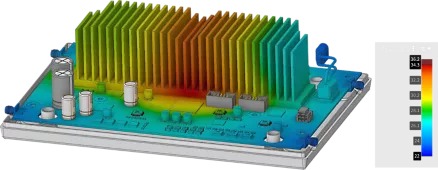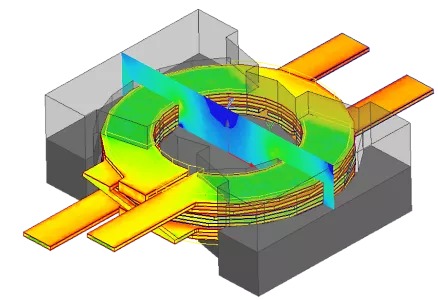PITTSBURGH, PA, Feb 5, 2025– Ansys 2025 R1 features refined digital engineering-enabling technologies that integrate with existing infrastructure, minimizing disruption and empowering teams to collaborate on innovative products. Powered by AI, cloud computing, GPUs, and HPC, Ansys R1 enhancements support faster decisions, collaborative decision-making, wider design explorations, and shorter product design times.
“Ansys 2025 R1 offers more integration capabilities than ever, helping teams carve a digital path through the entire lifecycle of a product, with tools and solutions to help expertly manage data pre- and post-development,” said Shane Emswiler, senior vice president of products at Ansys. “This release highlights that our solutions can serve as guideposts, helping disconnected teams stay the course and work collaboratively from a single, accessible source of truth. This not only significantly cuts costs, but it also accelerates time-to-market, which helps our customers stay competitive.”
Advanced Physics Solvers
Ensuring product performance begins with understanding the multiphysics involved, from the components to the system. The latest release from Ansys highlights new products and capabilities that deliver fast, high-fidelity, physics-based results, helping teams make informed decisions earlier in the design cycle:

- Ansys Discovery 3D simulation software significantly expands thermal modeling with the addition of electrothermal analysis, orthotropic conductivity, and internal fans while maintaining speed and ease of use
- The structural analysis suite features an integrated solution for noise, vibration, harshness (NVH), delivering 10x faster frequency response function (FRF) calculator, vibro-acoustics mapping, optimized meshing, and mode contribution analysis
- Ansys Electronics connects to other Ansys software products, enabling improved meshing that is crucial for 3D integrated circuits, automated workflow capabilities, and boosted simulation performance
- A new Polymer FEM product utilizes high-fidelity models to capture real-world materials behavior, addressing customers’ evolving materials simulation requirements
“The Ansys platform offers key advantages for Firefly as we rapidly innovate to support responsive space services,” said Brigette Oakes, vice president of engineering at Firefly Aerospace. “CFD is one area where Ansys shines – Fluent accurately models combustion dynamics and complex thermal interactions in our engine designs. Its integration of thermal and structural analysis simplifies workflows, and its user-friendly interface and responsive support team make it a critical tool for a fast-paced company like ours.”
Cloud, HPC and GPUs
Cloud computing, HPC, and GPUs are speeding up how modern products are developed. Key features like accessibility, interoperability, and scalability drive this progress, enabling users to move beyond traditional desktop tools and collaborate on more innovative products. Ansys R1 introduces improvements to its GPU solvers and adds web-based, on-demand features for multiple applications:

- The Ansys Fluent multi-GPU fluid simulation solver supports applications with large mesh cell counts, such as automotive external aerodynamics. This enables designers to include more variables to improve accuracy without compromising simulation speedAnsys CFD HPC Ultimate is a new product that enables enterprise-level CFD capabilities for one job on multiple CPU cores or GPUs without the need for additional HPC licenses
- New GPU-accelerated simulations in Ansys Lumerical FDTD advanced 3D electromagnetic simulation software uses 50% less GPU memory and provides a 20% reduction in meshing time compared to CPUs
- The Ansys Mechanical GPU-accelerated direct structural finite element analysis solver is up to 6x faster than alternative solutions and the iterative solver is 6x faster than CPU-only versions
- Ansys Cloud Burst Compute with Discovery empowers designers to solve 1,000 design variations in 10 minutes. Parametric studies in Discovery are accelerated by 100x or more by leveraging NVIDIA GPUs
- The Ansys Cloud Burst Compute capability provides elastic, flexible, on-demand HPC capacity for Ansys Mechanical, Fluent, and Ansys HFSS high-frequency electromagnetic simulation software
Artificial Intelligence
Ansys is expanding its tools with AI-powered technologies to improve speed, innovation, and usability in CAE industry. Its AI technology helps teams process new or existing data to evaluate designs in minutes, train custom AI models within minutes, accelerate product development, and and reduce costs:

- Ansys has developed an intuitive, interactive tool to streamline data preparation for SimAI modeling
- SimAI allows users to expand the training data to gain insight during post-processing, such as honing analysis around a specific component within a larger design
- Ansys Electronics AI+ uses AI-driven techniques to predict resources and runtime for electronics simulations in Ansys Maxwell advanced electromagnetic field solver, Ansys Icepak electronics cooling simulation software, and HFSS
- Advanced synthetic radar simulation within Ansys RF Channel Modeler high-fidelity wireless channel modeling software empowers the digital mission engineering community with a comprehensive training and validation dataset for ground-based AI target identification
“Ansys’ industry-leading simulation solutions will help drive Vertiv’s business model as we design solutions for the future,” said Steve Blackwell, vice president of engineering at Vertiv. “Our mission is to revolutionize the way the world conceptualizes and develops data centers — from cooling and power technologies through implementing AI in the design of the data center itself. With Ansys, we will more quickly meet critical milestones that will help us deliver the most optimal infrastructure to support our customers’ AI-based projects with energy-efficient and reliable future-forward designs.”
Connected Ecosystem
Cutting-edge R&D involves design methods like model-based systems engineering (MBSE) and automation to maintain efficient workflows. Ansys tools are flexible and scalable, allowing easy integration of new technologies into current infrastructure without disrupting product design. The Ansys 2025 R1 release includes updates that improve MBSE features and data management, simplifying the shift to digital processes:
- Ansys ModelCenter MBSE software and SAM support SysML v2, allowing enhanced product designs. This update improves team collaboration and makes product requirements simpler to access and use across engineering organization, saving time and boosting productivity.
- ModelCenter now has improved MBSE connectivity for better compatibility, including an enhanced Capella connector and deeper integration with Ansys SAM for intuitive search, save, and modification
- Ansys Minerva simulation process and data management software generic connector improvements help reduce the time and cost of implementation by standardizing how external data is brought into Minerva, allowing users to verify and resolve any conflicts before uploading. The connector also helps improve engineer productivity with new asynchronous job launch capabilities
Additional R1 Announcements also Include:

- Ansys optiSLang process integration and design optimization software include enhancements across interfaces, distributed computing, and more advanced algorithms, adding flexibility and performance to the design workflow
- Ansys Granta Materials Intelligence (MI) product collection’s integrations with CAE, computer-aided design, and product lifecycle management software now feature a unified user experience between the Granta end-user interface and the integration interfaces
- Task-based performance improvements made to the fault tolerant meshing and watertight meshing workflows in Fluent improve meshing speeds
- Ansys PowerX, a new tool for power field-effect transistor (FET) and power management integrated circuit (PMIC) analysis, simulation, and optimization.
About Ansys
Ansys, founded in 1970, specialized in engineering simulation software. It offers a comprehensive suite of tools for structural analysis, fluid dynamics, electromagnetic field simulation, and more, enabling industries to design and test products virtually. Ansys software has enabled innovators across industries to push boundaries by using the predictive power of simulation. Serving sectors such as aerospace and defense, automotive, energy, industrial equipment, materials and chemicals, consumer products, healthcare, and construction, Ansys supports innovation across diverse fields. As of 2023, the company reported annual revenues exceeding $2.3 billion and employed over 6,200 people worldwide. Headquartered in Canonsburg, Pennsylvania, Ansys continues to advance engineering simulation technologies, empowering organizations to enhance product development processes.
Source: ANSYS, Inc.
